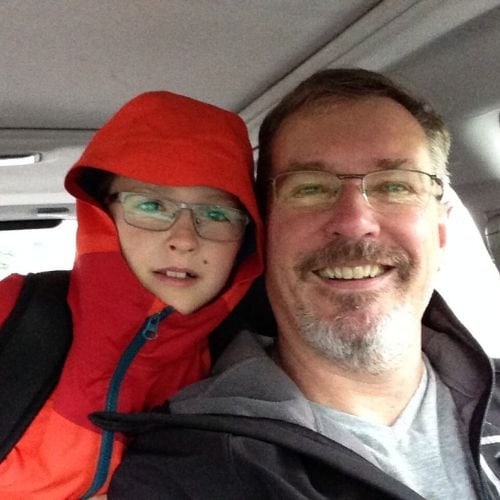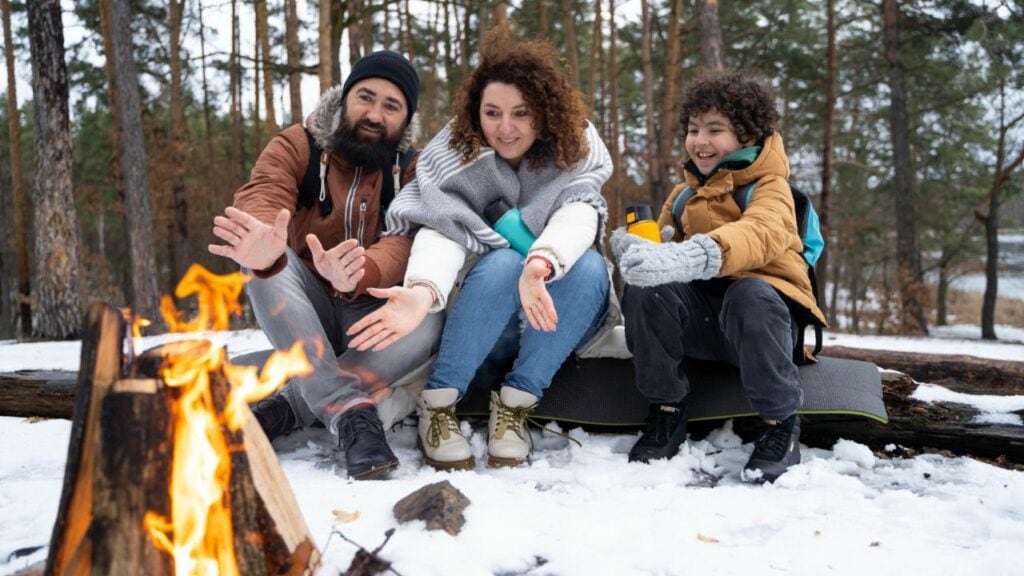We're an affiliate. We hope you love the products we recommend! Just so you know, we may collect a share of sales or other compensation from the links on this page. Thank you if you use our links, we really appreciate it!
Winter camping with kids can be a fun and memorable experience for the whole family, but it does require some extra preparation and precautions to ensure everyone stays safe and comfortable in the cold weather. If you’re planning a winter camping trip with your kids, there are a few things you should keep in mind to make the experience enjoyable and stress-free.
Your top priority should be making sure your kids are comfortable with camping before attempting a winter trip. If they don’t enjoy summer camping, they probably won’t enjoy winter camping, considering things can get a whole lot harder out in the elements in the winter. Consider starting with warm weather camping trips to get them used to the outdoors and build their confidence before moving on to colder temperatures. Once your kids are comfortable with camping during other parts of the year, you can start planning your winter adventure.
Planning and Preparing for the Trip
When you’re ready to attempt a winter camping trip with your kids, here are some tips to help you plan and prepare, so things go off smoothly.
Plan Ahead
Start planning your trip well in advance. Research the campground or area you plan to visit and make sure it’s open during the winter months. Check the weather forecast and pack accordingly. It’s also a good idea to have a backup plan in case the weather turns bad.
Pack the Right Gear
Make sure you have all the necessary gear for winter camping, including a four-season tent, sleeping bags rated for cold temperatures, warm clothing, and plenty of food and water. It’s also important to pack a first-aid kit and any medications your family members may need. Hand and feet warmers are a good idea for keeping everyone warm.
Test Run
Before you head out on your winter camping trip, you might try a test run in your backyard or a local park. This will give you a chance to practice setting up your tent, using your camping stove, and staying warm in colder temperatures.
Prepare for Emergencies
Winter camping can be unpredictable, so it’s important to be prepared for emergencies. Make sure you have a way to communicate with the outside world, such as a satellite phone or radio. It’s also a good idea to have a plan in case someone gets injured or lost.
Choosing the Right Camping Gear
When it comes to winter camping with kids, having the right gear can make all the difference. Here are some tips for choosing the right camping gear for your family:
Tents
Look for a 4-season tent or a winter tent that is designed to withstand cold temperatures and high winds. A tent with a vestibule can provide extra storage space for gear and muddy boots, as well as extra insulation from cold winds. Make sure the tent is big enough to accommodate your family comfortably.
Hammocks
While hammocks are not ideal for winter camping, they can still be a fun addition to your gear. Look for a hammock with an insulated pad or underquilt to keep you warm and comfortable.
Camp Stove
A reliable camp stove is a must-have for winter camping. Look for a stove that is designed for cold temperatures and has a built-in windscreen. Make sure to bring extra fuel and a backup stove just in case.
Firestarter
Starting a fire in the snow can be challenging, so make sure to bring a reliable firestarter. Waterproof matches, a lighter, or a firestarter kit can all be good options.
Camp Chairs
While it may be tempting to skimp on camp chairs, having a comfortable place to sit can make a big difference in your winter camping experience. Look for chairs that are lightweight and easy to pack, but still provide enough support and comfort.
Rainfly
A rainfly is essential for keeping your tent and gear dry in wet and snowy conditions. Look for a rainfly that is made from durable, waterproof material and is designed to fit your tent.
Dressing for Winter Camping
When it comes to winter camping with kids, dressing appropriately is crucial for keeping both you and them warm and comfortable. You want to make sure you and your children are dressed in layers that can be easily added or removed as needed.
Start with a wicking baselayer such as thermal underwear to keep moisture away from the skin. Add a mid-layer of fleece or flannel for insulation, and finish with a top layer that is wind and moisture-resistant. Experienced cold weather campers often wear 4 layers (an extra-thin base layer beneath their regular base layer), to have more control over temperature regulation.
Make sure to bring gloves or mittens to keep your hands warm, and consider packing hand warmers for extra warmth. A jacket with a hood is a must-have for protecting your head and neck from the cold, especially at night.
Setting Up the Campsite

Before you start setting up your campsite, make sure you have chosen a suitable location. If you are camping outside a campground, look for flat, dry ground on which to pitch your tent. If you are camping in a campground, follow the rules and regulations regarding where you can set up your campsite.
Once you have found the perfect spot, it’s time to start setting up. First, lay a tarp on the ground to protect your tent from moisture and damage — this is especially important if you are staking your tent in snow — then set up your tent atop that.
If you plan to have a campfire, make sure you have a designated fire pit and follow the rules and regulations for starting and maintaining a fire. Always keep a bucket of water nearby in case of emergencies. In the coldest weather, you may need to insulate this bucket to keep the water from freezing.
Keeping Warm and Safe

When camping in the winter with kids, keeping warm and safe is of utmost importance. Temperatures can drop drastically, and it’s essential to prepare for cold weather to get colder. Here are some tips to keep you and your children warm and safe during your winter camping trip:
Insulation is Key
Make sure to bring enough blankets and sleeping bags with adequate insulation. A double sleeping bag can be a great option for sharing body heat and keeping warm. Look for sleeping bags with high loft and sleeping pads with high R-value to ensure maximum insulation and warmth.
Stay Dry
Wet clothes can make you feel colder, so it’s essential to stay dry while cold-weather camping. Invest in waterproof clothing and a good waterproof tent to keep you and your kids dry.
Use Body Heat
Sharing body heat is an excellent way to stay warm when cold-weather camping. Consider a double sleeping bag or sleeping in close proximity to your children to share body heat. If things get really cold, you can use hot water bottles to warm up your sleeping bags before bed.
Stay Hydrated
Drinking enough water is essential for staying warm in cold weather. Make sure to bring enough water and encourage your kids to drink even if they don’t feel thirsty. Staying hydrated will help regulate body temperature and keep everyone warm.
Sleeping Arrangements
One of the most important aspects of winter camping with kids is ensuring that everyone stays warm and comfortable throughout the night. Here are some tips for creating a cozy sleeping setup:
- Sleeping bags: Make sure everyone has a sleeping bag rated for the temperatures you’ll be camping in. A good rule of thumb is to choose a bag that’s rated for 10-15 degrees colder than the lowest temperature you expect to encounter. Consider investing in high-quality down or synthetic bags, which will provide better insulation and compressibility than cheaper options.
- Sleeping pads: Even the warmest sleeping bag won’t keep you comfortable if you’re sleeping directly on the cold ground. Invest in a good-quality sleeping pad or two to provide insulation and cushioning. Closed-cell foam pads are lightweight and durable, while inflatable pads offer more comfort and insulation but are prone to punctures.
- Sleeping bag liners: For an extra layer of warmth and cleanliness, consider using a sleeping bag liner. These lightweight, washable liners can add up to 10 degrees of warmth to your bag and help keep it clean and fresh.
- LED nightlights: Winter nights are long and dark, and it’s important to have a source of light to help kids feel safe and comfortable. Invest in a few LED nightlights to place around the tent or camper, or consider using headlamps or lanterns for a more portable lighting solution.
Frequently Asked Questions
How can I ensure my kids stay warm while winter camping?
Keep your kids warm and comfortable while winter camping by dressing them in layers, including a warm base layer, insulating mid-layer, and a waterproof outer layer. Make sure they have warm hats, gloves, and socks, and consider investing in sleeping bags rated for colder temperatures. You’ll also need a four-season tent designed for winter, and extra blankets never hurts.
What are some family-friendly winter camping destinations?
There are many family-friendly winter camping destinations across the U.S. Some popular options include Yosemite National Park in California, Yellowstone National Park in Wyoming, and Acadia National Park in Maine. If you’re looking for something off the beaten path, consider exploring state parks or national forests in your area.
How do I prepare my kids for winter camping?
Preparing your kids for winter camping is essential for a successful trip. Start by getting them excited about the adventure and involving them in the planning process. Teach them about the gear and clothing they’ll need, and practice setting up your tent and campsite before you go.
Before embarking on your cold, winter adventure, consider taking a shorter camping trip in milder weather to help them acclimate to the outdoors, and make sure they understand the importance of staying warm, dry, and safe during the trip.

We’re passionate about getting the most from your car when it comes to going on adventures and road trips. When you take one of these trips you often need more room in your car than you usually would. This is when we come in, to help you find the best roof tent for your car and needs.

